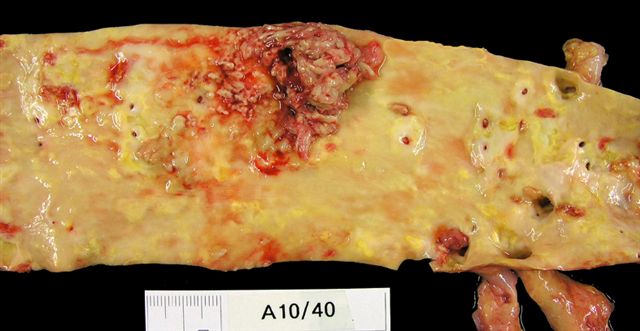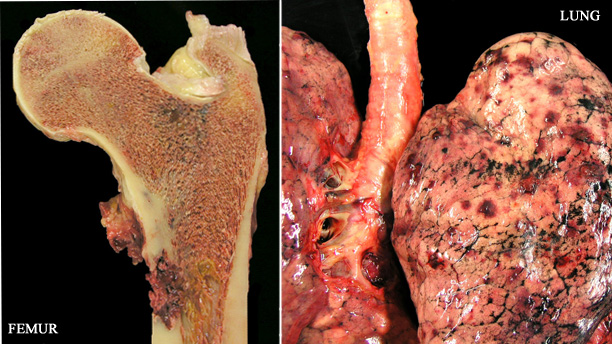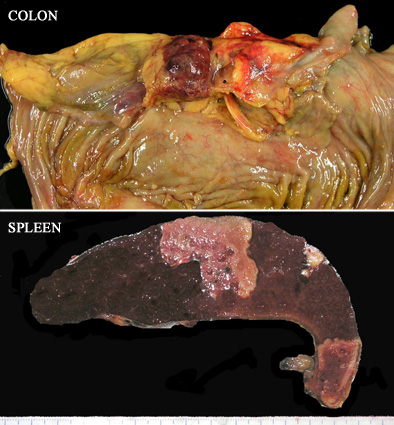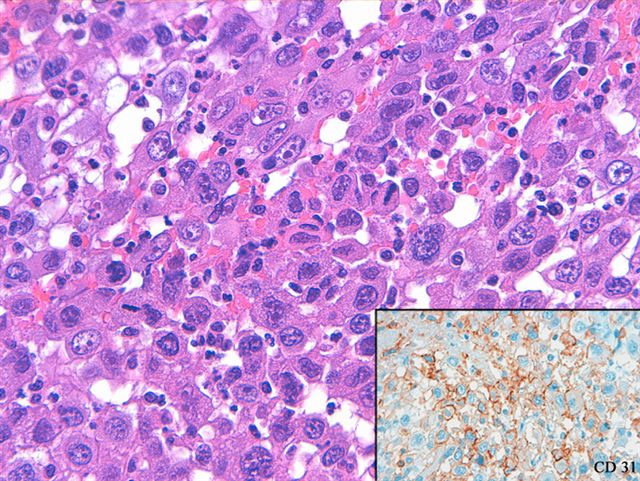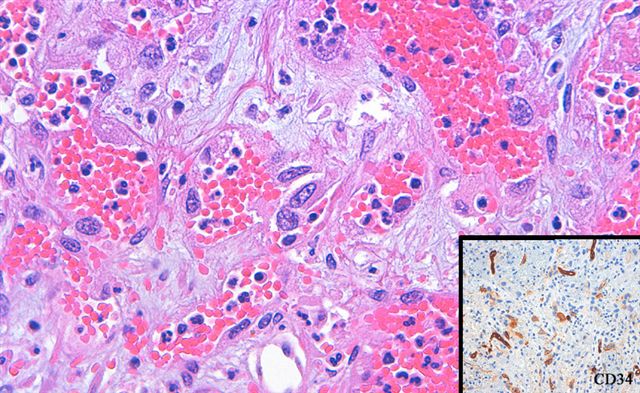11 May 2011 - Case #206
All cases are archived on our website. To view them sorted by case number, diagnosis or category, visit our main Case of the Month page. To subscribe or unsubscribe to Case of the Month or our other email lists, click here.
This case was contributed by Ana Martinez-Peñuela, Hospital de Navarra (Spain).

Modern Pathology: The Long Course Issue
A comprehensive update in thyroid and endocrine pathology for practicing pathologists and pathologists-in-training.
The Long Course Issue is comprised of lectures reviewing practical diagnostic and differential diagnostic issues and when appropriate, emphasizing the role of contemporary ancillary techniques. Access select articles from the Long Course Issue for the next three weeks only.
Click here for more information.
Advertisement
Case #206
Clinical history:
An 80 year old man was admitted for anemia and angina. Workup revealed hepatosplenomegaly and multiple splenic infarctions. He got worse and a splenectomy was performed. Further studies showed multiple lesions in bones, the gastrointestinal tract, pancreas, liver, peritoneum, lungs and both kidneys. 2 days after the surgery, the patient died. An autopsy was performed.
Gross images:
Microscopic images:
What is your diagnosis?
Diagnosis: Intimal sarcoma of abdominal aorta with multiple tumor emboli and metastasis with angiosarcomatous differentiation
Discussion:
Intimal sarcoma is defined as a malignant tumor arising in the tunica intima of large blood vessels. Most cases develop in the aorta and are undifferentiated. In undifferentiated cases, there is no gender preference and mean age is 66 years (Am J Surg Pathol 2005;29:1184). Tumors are typically largely necrotic, with poorly differentiated epithelioid and pleomorphic cells associated with the tunica intima. Tumors are considered to be of endothelial origin, due to immunoreactivity for CD31 and FLI1, with variable staining of other markers (Am J Surg Pathol 1988;12:798).
Metastatic tumors tend to have different morphology from the primary tumor, including angiosarcomatous (as in this case), osteosarcomatous or rhabdomyosarcomatous differentation.
Most patients have metastatic disease and die within 1 year of diagnosis. Tumors typically present with thromboemboli and postmortem diagnosis is common (J Bras Pneumol 2009;35:814, Hum Pathol 1997;28:1306).
All cases are archived on our website. To view them sorted by case number, diagnosis or category, visit our main Case of the Month page. To subscribe or unsubscribe to Case of the Month or our other email lists, click here.
This case was contributed by Ana Martinez-Peñuela, Hospital de Navarra (Spain).

A comprehensive update in thyroid and endocrine pathology for practicing pathologists and pathologists-in-training.
Website news:
(1) We are currently updating these chapters: Bladder, Cervix-Cytology, Drugs of interest to pathologists and Stains.
(2) We are always looking for reviewers of our chapters, or parts of chapters. If interested, email us your CV and the chapters / topics you are interested in reviewing. More information about reviewing is found here.
Visit and follow our Blog to see recent updates to the website.
(1) We are currently updating these chapters: Bladder, Cervix-Cytology, Drugs of interest to pathologists and Stains.
(2) We are always looking for reviewers of our chapters, or parts of chapters. If interested, email us your CV and the chapters / topics you are interested in reviewing. More information about reviewing is found here.
Visit and follow our Blog to see recent updates to the website.
Case #206
Clinical history:
An 80 year old man was admitted for anemia and angina. Workup revealed hepatosplenomegaly and multiple splenic infarctions. He got worse and a splenectomy was performed. Further studies showed multiple lesions in bones, the gastrointestinal tract, pancreas, liver, peritoneum, lungs and both kidneys. 2 days after the surgery, the patient died. An autopsy was performed.
Gross images:
Microscopic images:
What is your diagnosis?
Click here for diagnosis and discussion:
Diagnosis: Intimal sarcoma of abdominal aorta with multiple tumor emboli and metastasis with angiosarcomatous differentiation
Discussion:
Intimal sarcoma is defined as a malignant tumor arising in the tunica intima of large blood vessels. Most cases develop in the aorta and are undifferentiated. In undifferentiated cases, there is no gender preference and mean age is 66 years (Am J Surg Pathol 2005;29:1184). Tumors are typically largely necrotic, with poorly differentiated epithelioid and pleomorphic cells associated with the tunica intima. Tumors are considered to be of endothelial origin, due to immunoreactivity for CD31 and FLI1, with variable staining of other markers (Am J Surg Pathol 1988;12:798).
Metastatic tumors tend to have different morphology from the primary tumor, including angiosarcomatous (as in this case), osteosarcomatous or rhabdomyosarcomatous differentation.
Most patients have metastatic disease and die within 1 year of diagnosis. Tumors typically present with thromboemboli and postmortem diagnosis is common (J Bras Pneumol 2009;35:814, Hum Pathol 1997;28:1306).

